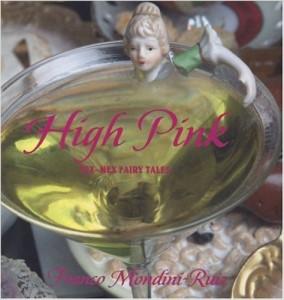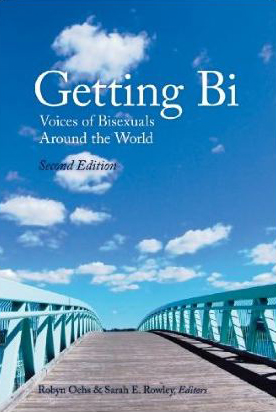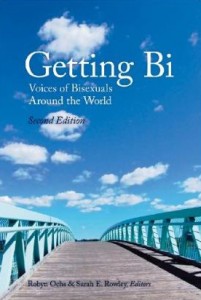Getting Bi: Voices of Bisexuals around the World
Edited by Robyn Ochs & Sarah E. Rowley
Bisexual Resource Center.
269 pages, $14.95
This anthology of personal, accessible narratives, culled from 300 submissions from 32 countries, presents a compelling look at contemporary bisexual experience. The statements were solicited and organized, and the book edited, by two bisexual activists. Robyn Ochs is the editor of Bisexual Resource Guide (now in its 4th edition) and co-founder of the Boston Bisexual Women’s Network, as well as the Bisexual Resource Center. She teaches college courses and workshops on bisexual identity, gender, and sexuality. Sarah E. Rowley is a member of the Boston Bisexual Women’s Network and an advocate for victims of domestic violence in the lesbian, bisexual, and transgender communities. The editors have arranged the contributors’ comments into chapters discussing bisexual identity and desire, coming out, creating relationships, building community, and taking political action. Commentary at the beginning of each chapter puts the individual statements in context. A catalog of useful resources and articles is included at the end. Bi people who read this book will find validation and community. Researchers and academicians will find the information they need to undertake more meaningful studies of bisexuality. The undeniably queer personal statements in this book should be of interest to people who wonder if it’s really necessary or appropriate to include the “B” in GLBT. And this book should be required reading for all screenwriters and authors who think that making a character bisexual is an expedient way to add an element of menace, ditziness, or debauchery to their story.
Kathryn Grannis
 Bi Men: Coming Out Every Which Way
Bi Men: Coming Out Every Which Way
Edited by Ron Jackson Suresha and Pete Chvany
Harrington Park Press. 329 pages, $19.95
It seems safe to say that bisexual men are nearly invisible, even within GLBT culture. While gay men and lesbians have long since staked out their territory and asserted their right to be, bisexuals (men more than women, it seems) have had a harder time of it. A sense of bisexual invisibility was the main impetus for Bi Men, an anthology of coming out memoirs. This invisibility is in marked contrast to a solid body of research that demonstrates just how prevalent male bisexuality is. The authors make no secret of the liberationist goal of this project, having sought to provide a place for “powerful, proud bisexual men’s voices.” The collection is structured in sections that model the actual coming out process: self-discovery; revelation of self to spouse and family; connecting with the community; and self-affirmation. The 34 pieces present a broad cross-section of the male bisexual experience. Many of these men are either married or have been married and struggle with two worlds, each with its own strands of desire. There are many stories of married men growing into the realization that they’re drawn to men, but there are also tales of gay men discovering (or rediscovering) an attraction to women. Ron Suresha’s “Coming to Terms” is one such story about a “late-blooming bisexual.” Others explore the effect of ethnicity on the formation of bisexual identity. Michael Gallardo’s “When the Head Is Separated from the Body” reflects on how the role of the family in Latino culture has influenced his development as a bisexual. Other contributors simply rejoice at the freedom to finally identify, publicly, as bi. Noted poet Alfred Corn concludes his essay with a simple declaration of independence: “I have never written about these things and never even spoken about most of this in private. It was time I did, and I’m glad I have.” No doubt many bisexual men will find the essays in this book a similar affirmation.
Jim Nawrocki
 High Pink: Tex-Mex Fairy Tales
High Pink: Tex-Mex Fairy Tales
by Franco Mondini-Ruiz
Distributed Art Publishers.
126 pages, $20.
Susan Sontag opened “Notes on ‘Camp’” with words that make sense of Franco Mondini-Ruiz: “many things have not been named, and many things, even if they have been named, have never been described.” Every object in High Pink is a known thing, but it is hard to name this art. A San Antonio-based artist and former ironic botanica owner, Mondini-Ruiz uses found objects, antiques, and food to assemble the 56 linked stories and images here. Objects happen to each other: “Taco Belle” wraps an 18th-century French figurine in a tortilla and sprinkles her with cheese; gooey chocolate cakes peer out of a purse while Mondini-Ruiz spins a tale of his dessert-stealing grandmother. Words and images collide, too. Ceramic figurines, onions, and cherry vanilla yogurt accompany the artist’s reflections on Cherry Vanilla, a minor star in Andy Warhol’s “fierce galaxy of queer superstardom.” “I wonder what Warhol would have thought of me. You must admit, the Factory was pretty much a white thing.” Like the images, his words masterfully display the art of the deliberate accident: puns, overheard conversations, witticisms, with a soupçon of insight that endures after the smile of the bon mot fades. And bitchy—bitchy in the way that makes you keep turning the page, bitchy enough that I’m a little afraid to review this book. In academic art journals, High Pink would be greeted with hosannas to “interpositionality.” The “Vassar-educated, art history major” and “Linda Ronstadt-look alike” that Mondini-Ruiz snarks so mercilessly offer easy prey for facile interpretations in light of the author’s multiple identities as a gay man, a Latino, a New Yorker, and an artist. But careful consumers of camp know the difference between false juxtaposition and brilliant accident, between art school poster food art and the pleasures of an old Linda Ronstadt LP. Mondini-Ruiz demands your serious attention, and then laughs at it. And that is High Pink’s greatest accomplishment: to convey what Sontag perceived in camp more than forty years ago: “another kind of truth about the human situation, another experience of what it is to be human—in short, another valid sensibility.”
Christopher Capozzola
 Inside Out: Straight Talk from a Gay Jock
Inside Out: Straight Talk from a Gay Jock
by Mark Tewksbury
Wiley. 288 pages, $24.95
In public, Mark Tewksbury has always credited the 1976 Olympics as a major inspiration for becoming an Olympic champion. In fact, what first sparked his love of swimming was wearing a towel-turban in imitation of his Grandma MacDonald when she swam in her condo’s pool. Intimate details such as these are what anchor Tewksbury’s story and give it relevance beyond the familiar “famous athlete overcomes his personal demons” yarn. To be sure, Tewksbury does cover all the usual challenges faced by high-performance athletes: the sacrifices, the pressure of being in the media spotlight, the post-Olympic depression. But it is his private sojourn as a gay man, from coming out of the closet to visiting his first gay bar—“It was like being in another world with fashionably dressed people drinking cocktails from martini glasses”—to entering his first sexual relationship (an ongoing, three-way arrangement with a male couple) that will resonate with many readers. The book’s subtitle, which seems intended to entice certain readers, may be somewhat off-putting for others. A self-described jock, Tewksbury also comes with all the tics and quirks of your everyday gay man wrestling with his sexuality, and later, with the complexities of dating and finding a partner. This is a thoughtful, moving narrative that inspires as much as it entertains.
Tony Peregrin







